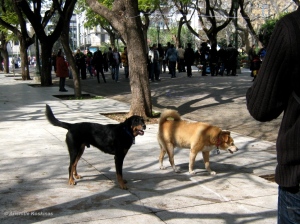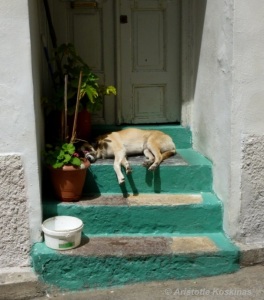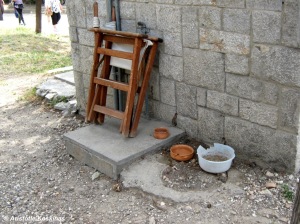Everywhere you go in Greece, you see dogs roaming about. They’re usually large, well fed and quite friendly. Some of them wear collars too. Are they strays?
Well, sort of. They are the city’s stray pets.
They seem to be kings of the city – there’s no place they can’t go. They sun themselves on doorsteps:
or even in the middle of the street:
They sleep in front of shop windows while owners and customers go about their business taking care to step around them:
Sometimes they even find their way into a quiet corner of a shop:
The street vendors let them take a nap next to their goods:
They seem to have a passion for culture, and often listen in during my tours:
They hang out at the Acropolis and other sites, and follow tourists around:
They know that, if they get hungry or thirsty, they’ll find a bowl of water and food behind the guard’s post:
Dogs like hanging around the city centre and large parks, where people with something to eat are to be found, while cats prefer to avoid crowds, especially if there are dogs around.
They like the quiet corners of archaeological sites, where nobody ever goes….
…and quiet, narrow alleys, like those in villages, or in Plaka:
They find the area of fish taverns and seaside cafés more to their liking….
…but they’re not above reading a book or magazine:
They like cars….
…but motorcycles are okay too:
And they’re not above being petted by someone who’s earned their trust:
So why are all those animals in the streets?
Well, you know how it is – someone gets a pet full of enthusiasm and then they abandon it for all the wrong reasons: it got too big for their flat or they can’t take it on vacation or they failed to neuter her and don’t want the litter. The Crisis has only made things worse.
There are many people who love animals and if they come across a newly abandoned stray, they will feed it, take it to the doctor and try to find a home for it.
However, the stark reality is that there are not enough homes for all the strays. Most Greek homes are small flats[1], with balconies instead of gardens, so there is a limit to how many animals one can have in one’s home.
With the vast majority of Greek households having at least one pet, conflicts may ensue…
So the animal gets released with a collar and tag and the would-be-owner keeps tabs on the animal, feeding it and taking to the doctor from time to time. It becomes a stray pet: it lives in the street, going where it pleases, but it knows where a friend with a bowl of food is to be found (and shelter too, on cold winter days).
Often the animal is taken care of by more than one person, while there are always kind passers-by that may slip them a snack or pet them.
The most famous stray pet must be Loukanikos (meaning “Sausage”), the dog that featured on Time magazine.
He got adopted by demonstrators during the protests that marked the beginning of the Crisis, and in turned adopted them, turning against the police.
After his death (of natural causes) he was immortalised on a wall in Psyrri (an Athens neighborhood that has become an open-air graffiti gallery).

Aren’t strays caught and put in shelters?
Sure, strays are not loved by anyone. There are many people who would rather see them off the streets for good, as well as those perverse souls who would rather abuse or even kill them. But they know they are in the minority, so they keep a low profile.
The authorities know well that if they attempted to trap, imprison and euthanize animals, there’d be an uproar. So they do the sensible thing: they catch-neuter-and-release any animal that is found without a collar. They give them their shots and tag them in order to keep an eye on them too.
They also put up feeding bowls for strays and alert people to the need for putting out water for the strays in the hot summer months. In most cases, this isn’t necessary. Sure, pickings in the business centre can be pretty thin during weekends, but in residential areas there are bowls of food and water around every corner.
Not only are there kind souls taking care of the neighborhood strays…
…but they often put up makeshift shelters for them on the sidewalk:
As for health care, most vets will check up a stray for free or at a discount. There are also volunteer pet clinics that set up shop in a different neighborhood once a month, offering to check-up or neuter for free every animal that is brought to them, whether stray or not.
So the strays of Greece live the good life, even enjoying the hospitality of 5-star hotels:
Not bad for a dog’s life, is it?
————————————————————-
[1] The average for a couple is roughly 30m2 (322 ft2); for a family of four about 90m2 (968 ft2).
Note 1: the images of Loukanikos are from the Pontiki and the Time Magazine.
Note 2: This article was written for fun, hence the playful tone. I’m not claiming that the situation is ideal – far from it. The strays of Greece are not an animal problem but a people problem: if everyone understood the responsibility and commitment that comes with an adoption, no animal would be sleeping in the street.
Note 3: For those of you who have a fear of dogs: Greek strays are usually quite docile and accustomed to people, as city authorities quickly identify and put in shelters new arrivals who tend to be aggressive. I’ve never heard of one attacking people, at least in Athens. However, instincts being instincts, some tend to chase after fast moving vehicles or joggers; also packs after a bitch in heat may be quite unpredictable. Keep your distance, don’t run and, if you feel threatened, swing a walking stick or a bag at them – this will make them keep a respectful distance.
Note 4: Rabies has been eradicated in Greece, with the last case reported in 1987.
Note 5: If you would like to help the stray animals of Greece, here is a comprehensive list of all the animal welfare organisations in Greece. Tip of the hat to Matt Barrett for compiling the list.



























Pingback: Photo of the week: parrot on a temple | Aristotle, Greek tourist guide
I remember watching a gang of dogs on a beach at Pireaus. They were in good health and wandered around together in good humour playing mild pranks and goofing around like a group of adolescent boys. It made me happy to watch them. it seemed that some belonged to boat workshops and some like you said were community pets. I had a dog in a Greek marina follow me for km on a walk. He was just happy to tag along. Can’t think they are getting on these days as people rarely have enough to eat.
Strange as it may seem, they haven’t grown thinner; it seems there’s always a little something to spare for them.
I’ve heard though that in the poorest rural areas and some islands the situation is far from good – too many strays and not enough people with enough to spare.
In greece animal suffer badly do many greeks looks on animals as tools and kill them brutaly!!! Its been so since i started travel ti greece 20 years ago, its not the crises its their their way to treat animals …
Dogs cats and other animals in greece are brutaly killed (POISION hanging beaten or killed by trafik, some exempel) by locals and gouverment in greece…animals are not neutred and soo many puppies are born and dumped in plastic bags as garbage!!!
Carina, you’re right, these things really do happen: people don’t neuter their pets, lots of animals are left in the streets and many are killed by traffic. And if you’ve read my post, you may have noticed that I mentioned people who abuse or kill animals. Yes, they exist, and they do use rat poison.
But none of the above is a uniquely Greek phenomenon. And you must have noticed in your travels that next to those animal-hating beasts there is a majority of people who love animals and will go out of their way to help them. For any animal-killing brute, I can give you dozens who do the exact opposite.
You must have been very unfortunate in your experiences in Greece, but I wouldn’t oversimplify things.
No this is not the Greek way and no, not all Greeks are like that. I’m sorry you’ve only met the wrong kind.
Pingback: Divas of the Acropolis | Aristotle, Greek tourist guide